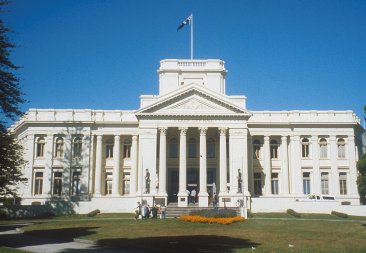|
|
|
Home | Introduction | Contents| Feedback | Map | Sources | Glossary |
|
33
St Kilda Town Hall
St Kilda Town Hall, 2002
St Kilda was one of
In 1863, St Kilda became a borough and in 1890, a city.
The triangular St Kilda Market Reserve was
bounded by
Pitt (1855-1918) briefly served articles from
1875, but by 1879 was already practising alone. That year he won first prize
for his design of the
In 1893, Pitt won another competition,
promoted by a friend of his father (artist and hotelier, William Pitt, Snr), for
the design of theatrical entrepreneur George Coppin’s
Our Lodgings (now Gordon House), Little
Another coffee palace followed, the 500 room
Federal (with Ellerker & Kilburn, architects of the
Priory (28)), now demolished. In
By 1891, when the financial crash came, he had leapt into another career, by successfully standing for the Victorian State Parliament, (1891-1910). As the economy recovered, he returned to architecture, designing several theatres and grandstands at Victoria Park (1892), Flemington and Caulfield Racecourses, and at the MCG (1905, now demolished).
Pitt could turn his hand, with exuberance and
eclectic invention, to many architectural styles. His Boom commercial palaces
exhibit ever richer and more sophisticated overlays of Mannerist manipulations
and effusive virtuosity. Yet St Kilda Town Hall is not his best work. It
appears to be a meaner, more compressed version of Charles Webb’s masterly
design for Emerald Hill (
Construction was slow and the economic crash
intervened. Pitt’s portico, capitals, distinguished steeply pitched slate roof
with oculi and high corner mansards, were never built. Nor was his spectacular
and inventive 54 metre high open tower, which would have been unique in
In 1892, rather than spend money completing
the building, a three-manual Fincham and
Hobday organ was purchased. In 1961 this was
enlarged and modernised. In 1903, the significant architect, Charles
d’Ebro designed a new portico and west wing for the
Town Hall. This also went no further. Then in 1925, another competition was held
and rather pedestrian architects
Of the 1938-39 additions, it is thought that B.S.W. Gilbertson designed the Supper Room interiors. Local architect and member of the Town Hall Committee Cr. Harry Raymond Johnson (1892-1954, 43), may well have acted as honorary architect for all of these additions, working in conjunction with the City Engineer’s Department. Plans were adopted and tenders called at a Council meeting in December 1938. Cr. Johnson moved all matters relating to these works at council meetings and no other designer was mentioned.
The works included the large new supper room,
(probably replacing an earlier timber one), Council chamber, Town Clerk’s suite
(subsequently the Blue Room), and another office. Land was purchased to enlarge
the grounds and the ornamental gates, fence and hedge removed, the gates went
off to another house in Toorak, it is said. In 1956, the St Kilda Town Hall was
the venue for the fencing events of the XVIthe
Olympiad, held form 23 November to 6 December. In 1957, the Town Hall exterior
was rendered in a plain, abstracted way, without Pitt’s Classical detail.
Internal renovations included the Mayor’s office (the St Kilda Room) and marble
stair. In 1971 a major wing was added along
Then, in April 1991, fire gutted the Town Hall. Arson was suspected. The municipal art collection then valued at $800,000 was lost, including Rupert Bunny’s The Forerunners, itself valued at $250,000. Community support was immediate for Mayor Melanie Eagle and her team, and a foundation stone for rebuilding was laid only a year later by Sir Zelman Cowen.
Because of the onerousness of the fire
regulations within Building Control in
Architects for the major redevelopment of the complex in 1992-94, after the fire, were Ashton Raggett McDougall (ARM), who were simultaneously designing a major addition to Enrico Taglietti’s Library, over Carlisle Street (1992-93, 32). A spectacular central arcade, lit by natural light affords a central spine, which resolves circulation between the previously disparate components of the complex. The cavernous town hall was divided into two functioning spaces by a glass screen, yet remains perceptibly a grand civic space.
Most architectural restoration in
ARM’s
Post-modernism burgeons into a veritable cornucopia of visual references, for
the architectural cognoscenti to unravel. Both the rear elevation and an
internal façade copycat the Alvar
Aalto’s Finlandia
Conference Centre and Concert Hall in
The Town Hall’s surprising interior is now one
of the most exciting and richly meaningful spaces in
In 1995, ARM’s design won two Royal Australian Institute of Architects awards: commendations for both architecture and interior architecture.
References Bick, David with Wilson Sayer Core Pty.Ltd. St Kilda Conservation Study. Area Two. (Undated).
Evans, Doug,
Executive Editor. Aardvark.
A Guide to Contemporary
Evans, Doug.
‘The Secret Life of Contemporary
Goad, Philip.
Mathews,
E.N.. Colonial Organs and
Organ Builders.
|
|
St Kilda Historical Society Inc. © 2005 |

